Shed Light On Your Air and GHG Calculations
Locus’ Air Quality app is designed to integrate with data sources to seamlessly calculate air emissions monthly or annually.
Locus’ Air Quality app is designed to integrate with data sources to seamlessly calculate air emissions monthly or annually.
2022 has given us a wealth of new features and growth! Both of our platforms have undergone improvements to enhance our client’s user experience. Let’s look at all the new features for 2022.
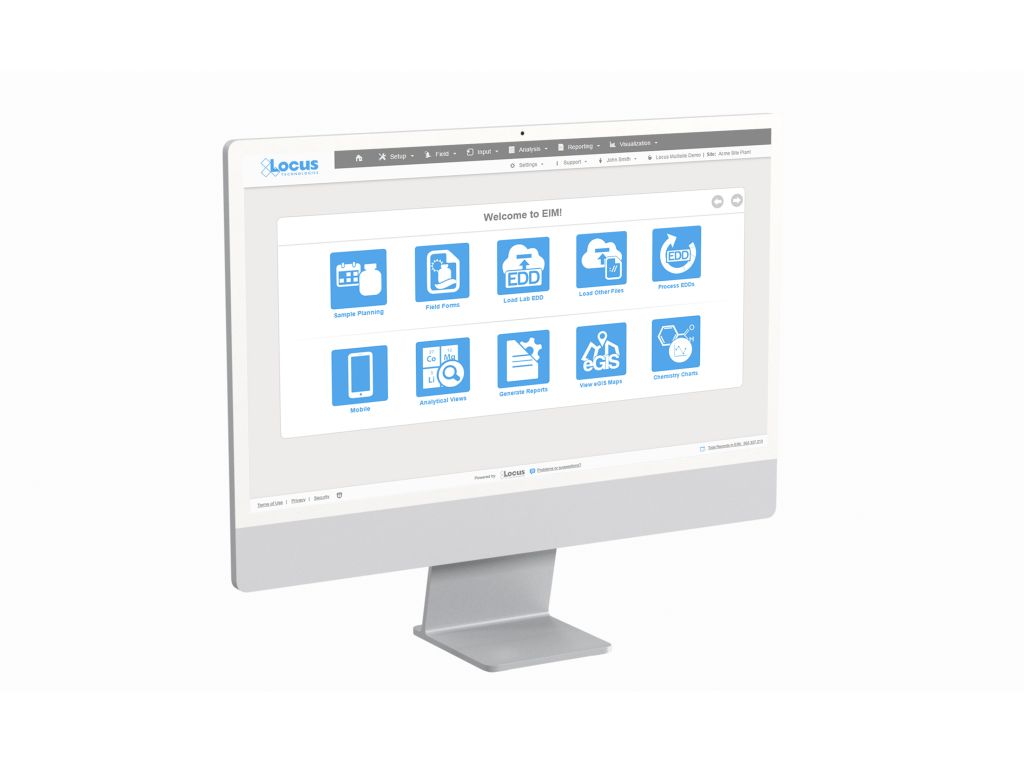
1. New Site Metrics dashboard allows immediate visibility into your data with clickable mapping. This is especially powerful for customers with multiple sites where they want to keep track of site activity and usage.
2. Finding data can sometimes be overwhelming especially when you have hundreds, if not thousands, of locations and numerous analytical parameters to review. Locus added advanced database search tools to support multiple search terms and ‘exact match’ searches, making it easy to find exactly what you want with a couple of key words and a click. Never has finding the right results from large complex datasets been so easy.
3. Locus has enhanced its API functionality to enable easier integration with external BI tools, including Tableau, PowerBI, and other apps. Now, customers that rely on external business analytical tools will have quick and easy access to data to combine with other internal data sources.
4. Locus document management has been taken to the next level by allowing customers to link documents from any external library directly into their sites, monitoring locations, samples, and more. This means with a simple click, users can go to lab reports, regulatory reports, and any other current or historical document associated with the site. If you are using SharePoint, for example, to manage documents – they can be accessed directly from Locus software. Document access and security will be preserved by existing document library access controls.
5. 2022 was the year of “help”. In addition to the advanced search, Locus added a new Help Browser to provide access to comprehensive documentation for every feature of the software. It is similar to the familiar “site map”, only the links take you to help content. With this new feature, users can view help in a single location vs having to access the information on each individual screen. For new users, or infrequent users, this will be their new favorite feature.
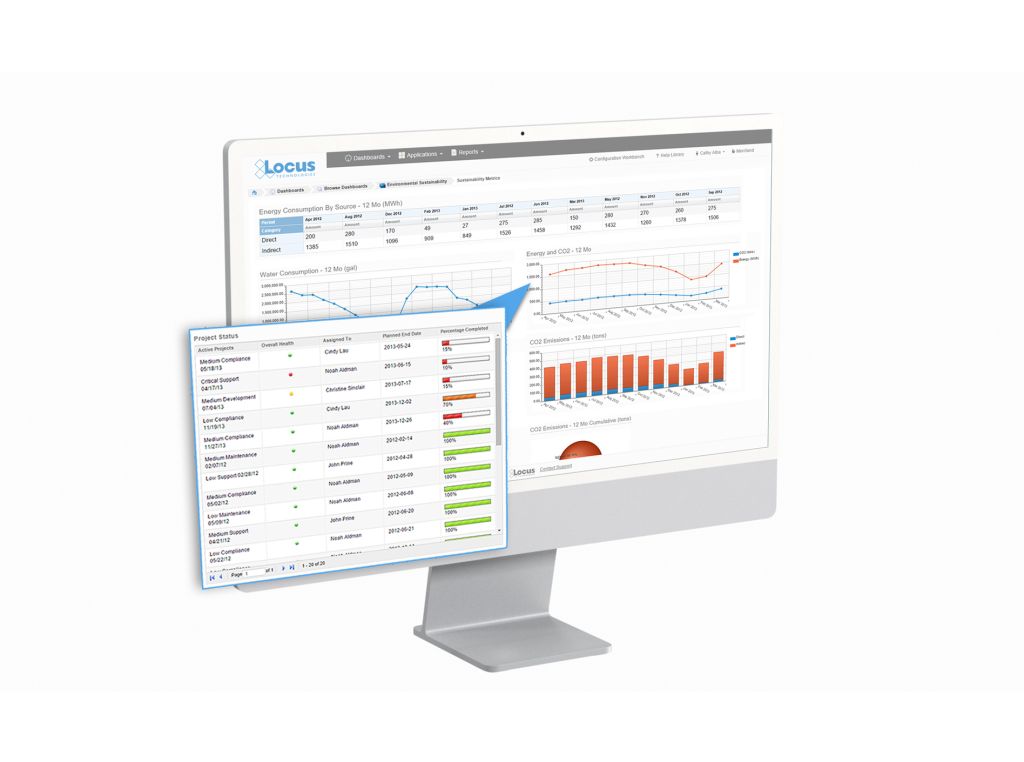
1. Locus’ Survey/Questionnaire tool enables you to securely & easily obtain data globally without the burdens of training or maintaining user lists. The survey system effortlessly supports data entry from external organizations (such as suppliers) or even occasional users internal to your organization, with a simple link click.
2. Locus released a new pivot table tool that enables you to perform full data analysis on any query in the system. Data may be grouped and organized by any value. Output options include bar charts, heatmaps, tables, area charts, scatter charts, and tree maps. In support of the output options, Locus has improved the ability for users to create dashboards more easily.
3. Complex inspection and audit forms require branching, sophisticated, scoring, and automated responses. Locus added new question types to its inspection/ audit module, including conditional questions based on responses to one or more previous questions. Locus augmented the scoring calculation mechanism and automated creation and tracking of corrective action.
4. In today’s world, users need access to environmental data on the go. Locus augmented its mobile offerings to include configurable layouts for mobile users, with compact forms specially designed for smartphone and tablet access.
5. Today’s managers want immediate access to the data they need. Locus’ new Landing Page feature makes it simple to configure the dashboards, bookmarks, and record lists. This enables the user to review just the areas they need to see and navigate efficiently to complete the work.
One of the biggest recent trends we have seen with novice ESG providers (both startups and major software providers new to the field) is a lack of substantial software tools presented. What is lacking is covered up by grandiose statements about the efficacy of their options. These statements are so vague that they could cover anything if you switched out references to ESG with any other nouns, since these providers don’t show their tools transparently.

When selecting an ESG software solution, don’t waste your time with something that either isn’t functional or doesn’t exist. More importantly, your software should have a long track record of usability and be backed by years of expertise. Locus ESG software is proven and is a vital part of the Port Authority of New York and New Jersey’s Clean Construction Program. It also helps Del Monte Foods meet their sustainability goals by improving analyzation and forecasting.
Is ESG the new gold rush? Some tech giants and startups seem to think so. With each passing day, more and more software providers throw their hat into the burgeoning ESG ring, hoping to cash in. While it’s perfectly reasonable for these companies to seek out profitable endeavors, most of those companies have limited real-world experience with ESG reporting and software. You may want to think twice about trusting your critical ESG reporting to someone looking to ride the wave toward a quick buck.
Locus has been developing and supporting ESG solutions for over two decades, before the ESG acronym ever made its way into headlines and boardrooms. In addition to the years of experience, Locus places great emphasis on domain knowledge, hiring experts in environmental science, engineering, sustainability, and mathematics to name a few. Our solutions are built and supported by these qualified experts, opposed to developers who are frantically cobbling together a solution that they can rush to market.
It takes years to develop a foolproof system for handling massive quantities of complex data. In a recent piece written by President of Locus, Wes Hawthorne, he delves into the importance of having accurate, audit-ready ESG reporting. Data quality and reporting accuracy have been pillars of Locus’ success since our founding in 1997.
Do more for your ESG program than applying a cookie-cutter tool meant to meet the bare-minimum needs of the many or an application that is new and untested, and unfit for your requirements. Our robust solutions help you manage impact, create reports with ease, and meet your ESG goals effectively.
Locus provides multiple methods to populate EHS, ESG, or any environmental data, including the following:
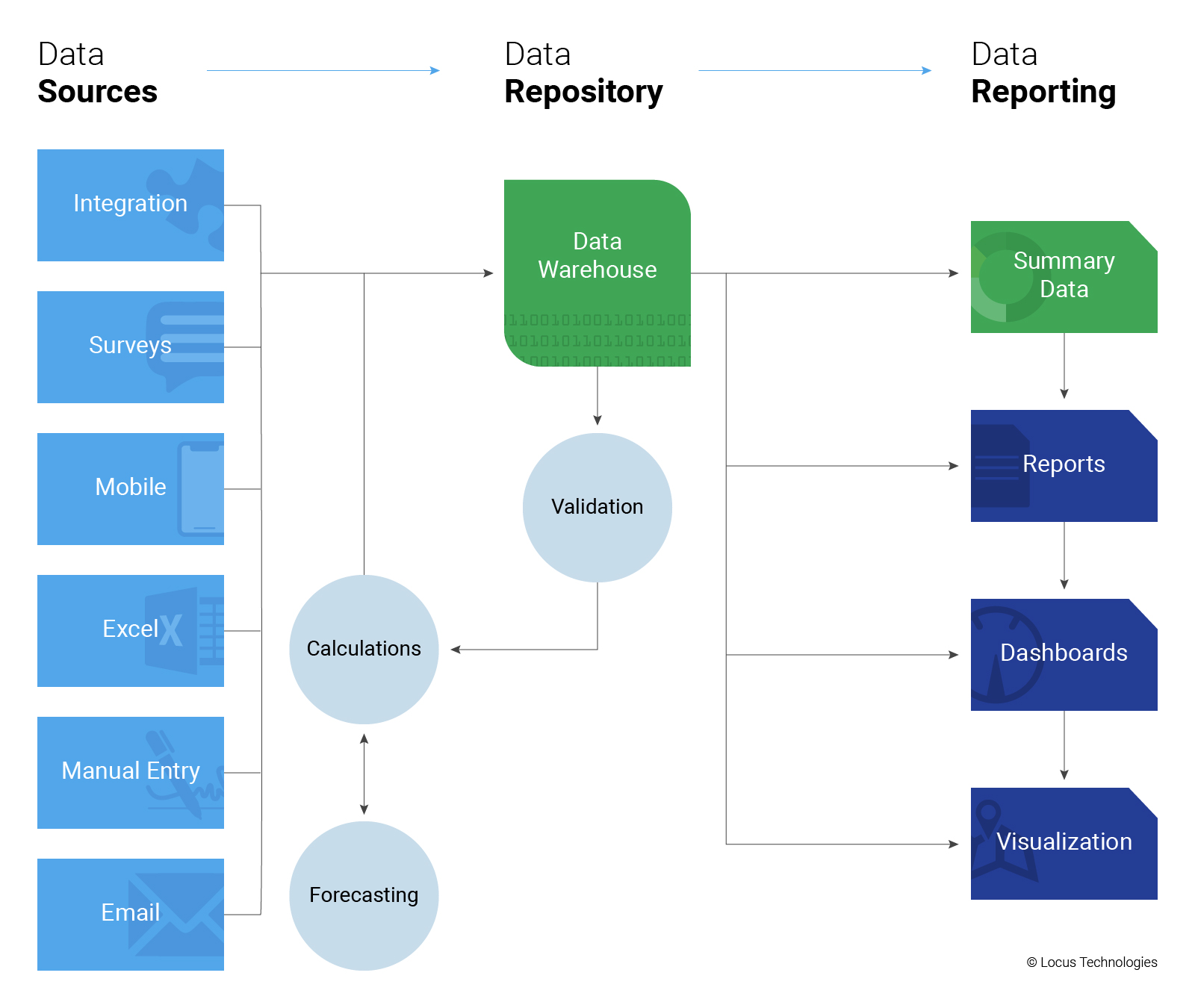
Locus provides a full suite of REST API’s, and SDK that can be used to populate data from external data sources. Typical uses include utility data, CEMS, meter data and IoT data.
Locus Survey tool enables you to issue survey questionnaires to people outside your organization, and enables them to securely and seamlessly respond directly into the survey form. Typical uses include supplier surveys, audits and customer questionnaires.
User input forms can be optimized for input on a phone or tablet, which allows quick uploads of photos and also geotags your data so you can ensure it was collected at the right location.
Locus provides a full suite of Excel upload tools that allow you to import data directly from Excel or CSV files. This option also allows you to work offline and re-sync your data later. Typical uses include laboratory data, periodic monitoring data and data migrations.
Like any system, Locus provides tools for users to directly enter data into the system. These include Locus sophisticated data validation tools which employs machine learning techniques to identify data entries which may be invalid, with visual indications of the expect range or ranges.
Locus can be configured to directly read email input (as text) and place it into the system. Typical uses include instances where external users initiate a conversation, which then may be responded to from within the system, such as an inquiry, issue, or an incident report.
The Vapor Intrusion tools in Locus’ Environmental Information Management (EIM) software solve the problem of time-consuming monitoring, reporting, and mitigation by automating data assembly, calculations, and reporting.
Quickly and easily generate validated reports in approved formats, with all of the calculations completed according to your specific regulatory requirements. Companies can set up EIM for its investigation sites and realize immediate cost and time savings during each reporting period.
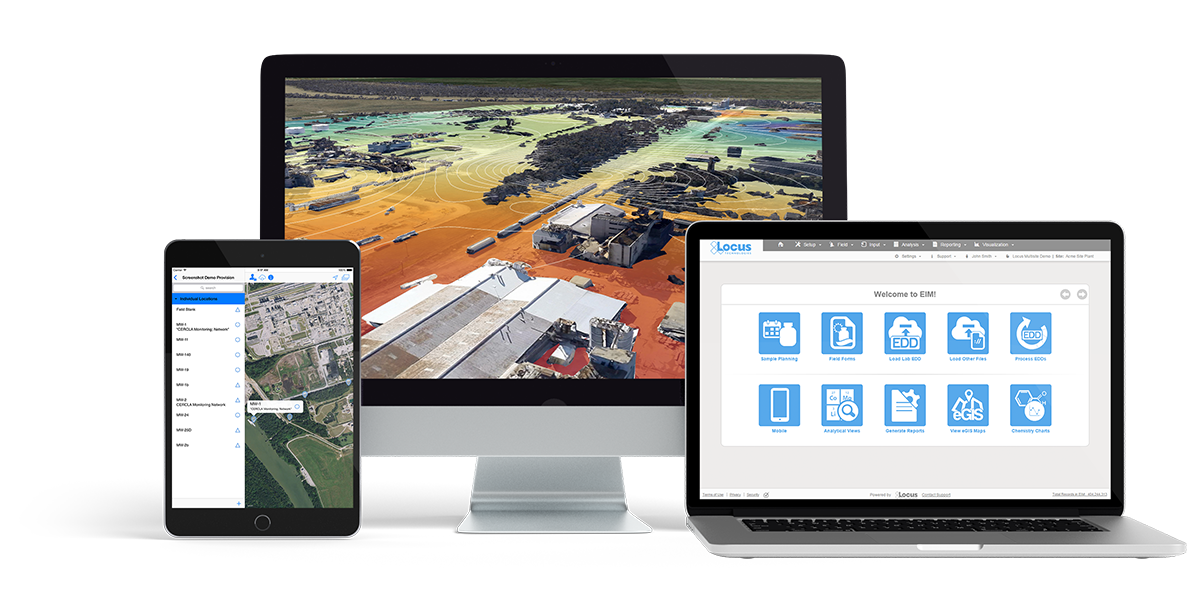
Companies across a wide array of industries utilize Locus Environmental Information Management (EIM) software. Some examples include petroleum companies with over 6,000 sites, fracking companies with 3,000 plus sites, leading chemical corporations, engineering firms, private and public water utilities, DOE facilities, Native American tribes, aerospace companies, representatives of the electronics industry, and more. There is not a single report that these companies share in common, and as such, our approach to reporting recognizes our customers’ diversity.
Instead of focusing on canned reports, we provide users with the tools to build their own custom reports—enabling them to design exactly what they need, either independently or along with our stellar support team. To make the transition to Locus EIM as easy as possible, we ask our customers about their top reporting priorities. Then, we build reports to match their specifications during the implementation process to be up and running from day one. Not only does this facilitate the transition to our system, but it also gives our customers examples of how to build their custom reports.
Before we delve into EIM’s formatted reports module, keep in mind that many of our customers’ reporting needs are met by EIM’s grids. For example, here is a sample grid populated with analytical results that match some previously chosen selection criteria:
One-click and this becomes an Excel spreadsheet (or any of a range of file formats) to which you can add a title, edit the column headers as needed, and if required, engage in further formatting.
Let’s now move on to EIM’s formatted reports module. Templates provide EIM with instructions concerning report layouts, content, and formatting. They do not address which records stored in EIM are to appear in the report. Template creation requires more in-depth knowledge of EIM and needs to be done only once for any given report format. Running a report is a more straightforward task. The same report can be re-run any number of times using different selection criteria. For example, it is not uncommon for a customer to print a monthly, quarterly, or even annual report using the same template. All that changes from one reporting period to the next is the selected sampling or measurement date range. Upon saving your entries, the report is ready to be used by others, unless designated as private.
To run a formatted report in EIM, all you need to know is what filters should be chosen to display only the relevant set of data. Aside from date ranges, what are examples of selection criteria available to you when executing a formatted report? For example, you can select individual locations or named location groups; individual or named groups of parameters; one or more sample types, sample purposes, samples, sampling programs, sampling events, or sample delivery groups; a range of sample depths; only filtered or unfiltered samples; only leached or not leached analyses; one or more EDDs; and one or more work order numbers to name a few.
The expert query tool allows the user to retrieve records from many EIM data tables with a flexible interface, where join and column definitions are customized. The expert query output can be scheduled as an attachment to an email or run as needed, private or public, or saved on the dashboard for ultimate access by all user levels.
The EIM Expert Query Tool (EQT) lets users create their database queries using a drag-and-drop table interface. Users can also directly write T-SQL language requests to pull data from EIM. This powerful tool empowers the super users to take full advantage of the data managed in EIM and creates “custom reports” without the need for a developer.
Additional reports include DMR reports (formatted and NetDMR); Self-monitoring; Regulatory formatted exports (various EPA regions); Consumer Confidence Reports; Data Validation (in association with the Data Validation Module); Coliform reports (Water configuration); custom DMR reports and custom MSGP reports; and a wide range of metric reports for usage statistics, records, sites, and management reports including holding table metrics, SDG turnaround times, reporting tool metrics, and LocusDocs metrics.
Recently, Locus CEO Neno Duplan described the need for credible ESG Reporting, and the evolving corporate, financial, and political drivers leading to the proliferation of ESG reporting. Here, we look at some of the practical aspects of building and maintaining an ESG reporting program. After leading audits for greenhouse gas emissions and other ESG metrics for the past ten years, I wanted to highlight the pitfalls that many organizations face when it comes to supporting their ESG reports, and provide some solutions to improve their auditability.

With the current wave of popularity for Environmental, Social, and Governance (ESG) reporting, many organizations are scrambling to assemble reports that cover these metrics. While a spreadsheet can be readily put together with enterprise-level totals for emissions, resource consumption, community involvement and other metrics, most of those reports won’t stand up to a full audit process. And increasingly savvy investors and stakeholders aren’t necessarily willing to take these reports at face value.
Whether you are getting started on a new ESG reporting program for your organization, or transforming an existing CSR program to cover ESG elements, it is critical to plan ahead for ensuring your final report is audit-ready. That means not only maintaining full visibility for the raw data, calculations, and various factors that went into the report, but also making that data easily accessible and traceable. Consider the case where a stakeholder is comparing two ESG reports where the overall metrics are similar. But one of the reports has a fully transparent data flow back to the source, and the other report can only be verified through a lengthy documentation request to a consultant. Although the final reports may be similar, the stakeholder gains more trust with less effort when the supporting data is readily available.

There is quite a bit of uncertainty over how comprehensive ESG audits should be. Current audit protocols for ESG reporting vary widely. Organizations like the Center for Audit Quality have put forth guidance on how ESG reports could be audited. However, there are no strict requirements and little consensus on what should or should not be included in the audit of an ESG report. Established reporting frameworks like GRI, SASB, and TCFD have programs in place for assurance of those reports, which include a third-party audit for the accuracy and completeness of that data. However, organizations have the choice of achieving either limited assurance or reasonable assurance, and they may choose to have only select metrics or disclosures audited, or they may opt to undergo a more thorough examination that covers the full report. That flexibility is likely to change, however, as stakeholders apply additional pressure for better quality and reliability in ESG reports.
So how do you go about developing an ESG program that can meet current and potential future audit requirements? Based on my auditing experience, here are a few key concepts to keep in mind:
Centralize your data flow, with consistent data quality controls. A unified data collection program is key to streamlining the audit process and having greater confidence in your report. Historically, reporting for ESG has been the responsibility of multiple departments with little intercommunication. The result of that separation is widely different practices when it comes to assuring data quality. Integrations between systems can help and are sometimes the best option to bring together data from different sectors of the ESG report. But ultimately, a consistent approach to the overall data collection and processing effort will result in a much smoother (and cheaper) audit.
Automate data collection wherever possible. Auditors know that manual data entry or transcription is typically one of the major weak points in any data collection program. We’re trained to focus in on those parts of the process with additional data sampling and review to find errors. If you have any opportunities to collect data through automated tools or direct connections to reliable data sources, those tools are the quickest ways to shore up those potential weaknesses, and also have the benefit of substantially reducing your ESG data collection effort.
Maintain documentation throughout the data collection process. During one audit years ago, I asked the reporter for their documentation on their electricity consumption, and they pointed to a scribbled sticky note on their wall. Of course, that didn’t quite suffice for audit purposes, and neither does an email from a co-worker, or any number of other data sources that reporters have tried to pass off as their documentation. For inputs that derive from sources outside your organization, like utility invoices or supplier surveys, data are considered more reliable if they are directly tied to a financial transaction between entities that do not share ownership. The general thought is that if the data quality was considered sufficient to exchange money based on the value, it can be considered reasonably accurate. If that is not the case, ideally an attestation, or at least the source’s contact information, should be maintained for each data source. For data inputs derived from internal sources (e.g. meter readings), the documentation will need to include the data itself, as well as information on the devices used and their maintenance (e.g. calibration records).
Given the many issues with spreadsheet data handling including lack of unification, security, and error proliferation and persistence, many organizations are correctly concluding that a dedicated software application provides numerous process improvements for ESG reporting. But unfortunately there are many software tools that take the input data and generate an ESG report with little or no visibility into how the input data were processed or calculated. And to an auditor, those part of the process are critical to achieving assurance for an ESG report. Sometimes the data processing steps can be viewed, but they’re buried within the configuration settings and require navigation by a system administrator to extract. In this situation, auditors can try to replicate the calculations from the raw data on their own, and attempt to yield the same results. This approach can work for many accounting metrics, which are largely standardized, and easily replicable from the input data. However, other metrics like Scope 3 emission calculations can follow a number of different methodologies with different factors. Without knowing which methods and factors were used, the auditor is unlikely to yield the same results. Having a transparent calculation engine that can visualize the data flow and processing can make a huge difference when it comes to your audit.
Assembling an ESG reporting program is a significant undertaking, and it may be a monumental effort to simply get the report done, especially if you’re just getting your program started. But to fully set yourself up for long-term success, be sure to assess the audit readiness of your ESG program. Even though ESG auditing is not yet fully codified, more formalized audit protocols are expected soon. Some simple considerations early in your program development will make sure you are prepared for whatever those audit requirements may include.
About the Author—J. Wesley Hawthorne, President of Locus Technologies
Mr. Hawthorne has been with Locus since 1999, working on development and implementation of services and solutions in the areas of environmental compliance, remediation, and sustainability. As President, he currently leads the overall product development and operations of the company. As a seasoned environmental and engineering executive, Hawthorne incorporates innovative analytical tools and methods to develop strategies for customers for portfolio analysis, project implementation, and management. His comprehensive knowledge of technical and environmental compliance best practices and laws enable him to create customized, cost-effective and customer-focused solutions for the specialized needs of each customer.
Mr. Hawthorne holds an M.S. in Environmental Engineering from Stanford University and B.S. degrees in Geology and Geological Engineering from Purdue University. He is registered both as a Professional Engineer and Professional Geologist, and is also accredited as Lead Verifier for the Greenhouse Gas Emissions and Low Carbon Fuel Standard programs by the California Air Resources Board.
Maybe you are a user of Locus’ Environmental Software (EIM) and are looking to get more out of our product. Or perhaps you are using another company’s software platform and looking to make a switch to Locus’ award-winning solution. Either way, there are some features that you may not know exist, as Locus software is always evolving by adding more functionality for a range of customer needs. Here are five features of our environmental software that you may not know about:
Locus expanded the EIM application programming interface (API) to support running any EIM Expert Query. Using a drag and drop interface, an EIM user can create an Expert Query to construct a custom SQL query that returns data from any EIM data table. The user can then call the Expert Query through the API from a web browser or any application that can consume a REST API. The API returns the results in JSON format for download or use in another program. EIM power users will find the expanded API extremely useful for generating custom data reports and for bringing EIM data into other applications.
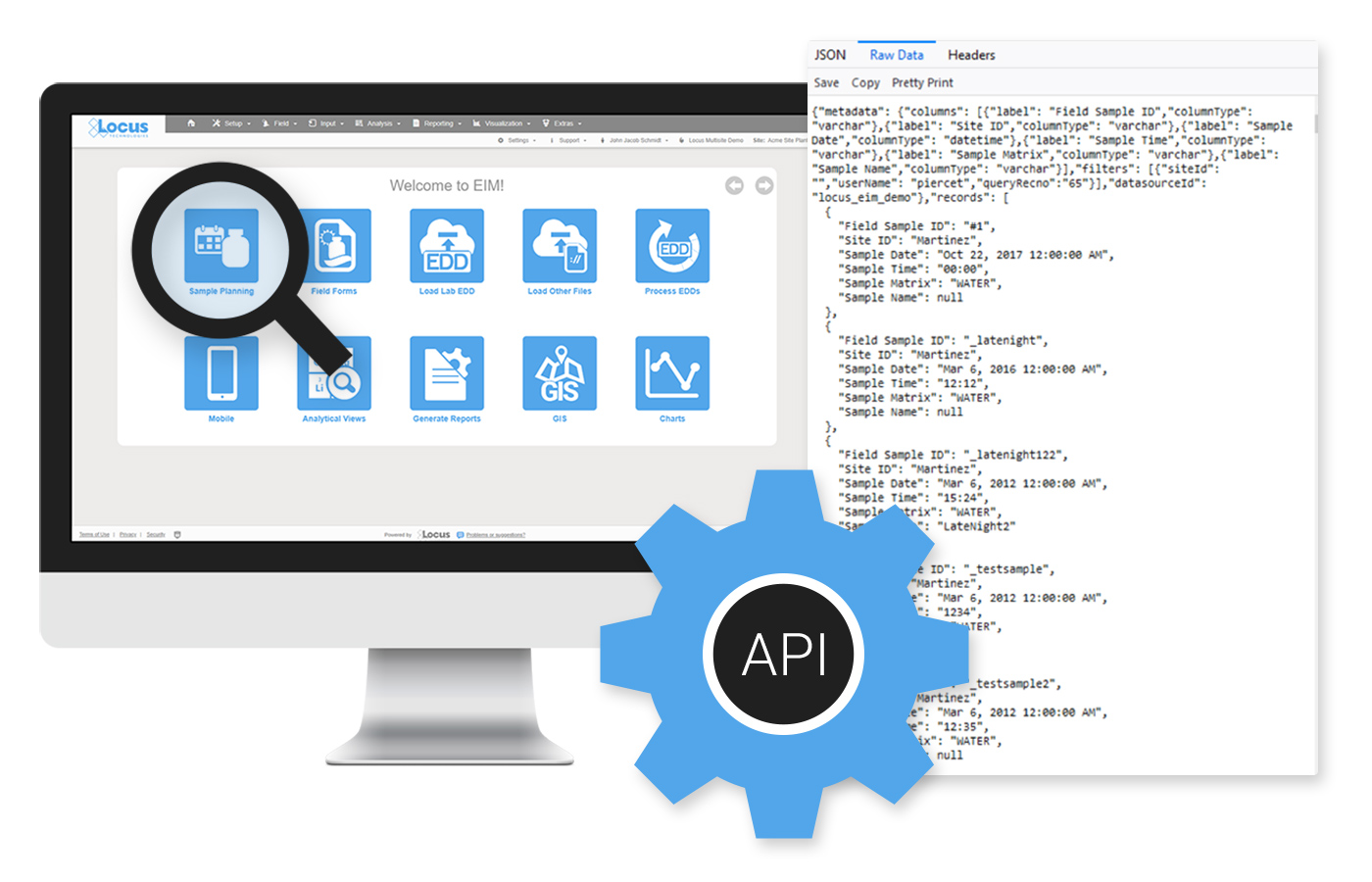
The Expert Query Builder lets users schedule their custom queries to run at given times with output provided in an FTP folder or email attachment. Users can view generated files through the scheduler in a log grid, and configure notifications when queries are complete. Users can scheduled queries to run on a daily, weekly, monthly, or yearly basis, or to run after an electronic data deliverable (EDD) of a specified format is loaded to EIM. Best of all, these queries can be instantly ran and configured from the dashboard.
Multiple charts can be created in EIM at one time. Charts can then be formatted using the Format tab. Formatting can include the ability to add milestone lines and shaded date ranges for specific dates on the x axis. The user can also change font, legend location, line colors, marker sizes and types, date formats, legend text, axis labels, grid line intervals or background colors. In addition, users can choose to display lab qualifiers next to non-detects, show non-detects as white filled points, show results next to data points, add footnotes, change the y-axis to log scale, and more. All of the format options can be saved as a chart style set and applied to sets of charts when they are created.
To help customers find the correct EIM menu function, Locus added a search box at the top right of EIM. The search box returns any menu items that match the user’s entered search term.
When the user runs the template for a specific set of locations, EIM displays the callouts in Locus’ premium GIS software, GIS+, as a set of draggable boxes. The user can finalize the callouts in the GIS+ print view and then send the resulting map to a printer or export the map to a PDF file.
Let’s look back on the most exciting new features and changes made in EIM, Locus’ environmental data management software, during 2020!
Sorry, no posts matched your criteria
Locus Technologies » Reporting » Page 6
299 Fairchild Drive
Mountain View, CA 94043
P: +1 (650) 960-1640
F: +1 (415) 360-5889
Locus Technologies provides cloud-based environmental software and mobile solutions for EHS, sustainability management, GHG reporting, water quality management, risk management, and analytical, geologic, and ecologic environmental data management.
